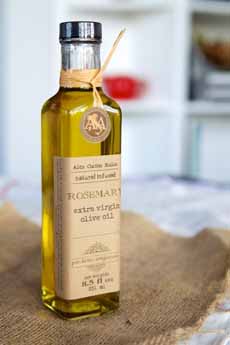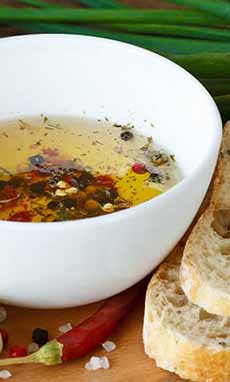
Basil, rosemary and other infused olive oils have a life beyond salad (photo courtesy Alta Cucina Italia).

[2] Garlic olive oil with crushed red pepper and tri-color peppercorns (photo courtesy Style Craze).

[3] Use olive oil and herbs as pasta sauce. Here, garlic, crushed red pepper do the trick. See the recipe from Real Simple.

[4] Mashed potatoes with truffle oil and truffle bits. You can use portobello bits or omit entirely (photo courtesy Williams-Sonoma).
|
|
If you’re a good cook, you probably own more than one flavored or infused olive oil. We own basil, chile, citrus (blood orange, lemon, lime), garlic, rosemary and truffle oil. We’re either a very good cook or an impulsive shopper.
There’s a difference between flavored and infused, although not many people know it. The front label of the bottle may not tell you, but a look at the ingredients label might.
Flavored olive oil has been flavored with an agent such as an alcohol-based flavor extract. A heat process is often used to bind the oil to the flavoring agent.
Infused olive oil, a more expensive process, is produced by cold pressing (crushing) the fruit or herb directly with the olives. Because crushing provides a more delicate taste than extracts, the added flavor doesn’t overwhelm the nuances of the olives. Rather, it provides a truly natural lilt of fresh flavor.
Oil quality: When you’re purchasing oil, it’s also important to note the quality of the base oil used. If the price is particularly good, it may often be simple refined olive oil, not virgin or extra virgin olive oil. The manufacturer counts on the extract to overcome any deficiencies in the olive oil flavor.
It doesn’t have to be EVOO. We’ve also had delicious, infused avocado and macadamia nut oils.
Check out the different types of olive oil in our Olive Oil Glossary.
USING FLAVORED / INFUSED OILS
We love flavored/infused oils, and tend to buy too many different flavors, that stand shoulder to shoulder in the pantry.
Open* bottles of olive oil have a particular shelf life, depending on olive variety and storage conditions. Flavored oils have an even shorter time before freshness fades. Try to use them within six months, and certainly within a year.
That’s why we look for opportunities to use them on a daily basis.
Note that just as wines pair to specific foods, so do olive oil flavors. Those flavors that are good for meats, such as chile or garlic, may be too strong for delicate fish. For the latter, use oils with citrus or green herbs.
Note that quality olive oils are not meant to be cooked at higher temperatures or for longer times.
A scrambled egg cooks quickly and over moderate heat. So we like to cook ours in basil, garlic or rosemary oil.
For something longer and/or hotter, add the flavored/infused oil towards the end.
For very high heat, like frying or stir-frying, use a different oil.
Of course, some preparations require no cooking: bread dippers, mashed potatoes, salad.
And now, 20 ways to use flavored/infused oils:
Baked or mashed potatoes (better for you than butter; truffle or wasabi oil is dynamite!)
Basting
Bread dippers
Caprese salad
Cooked grains (drizzle)
Eggs (cook scrambled eggs or omelets in it)
Fruit salad
Garlic bread, bruschettta, crostini (the difference)
Herb substitute (if you don’t have an herb needed for a recipe, splash some infused oil)
Garnish (drizzle on top of hummus, soup, as a plate garnish, etc.)
Grilled fruit
Grilling (rub onto raw fish or meat)
Homemade mayonnaise (recipe)
Marinades
Olive oil cake (particularly basil, blood orange/other citrus, rosemary and sage)
Pasta: use olive oil as the sauce (plus cheese and any mix-ins you like)
Pizza drizzle
Sautéeing chicken and fish
Steamed or roasted potatoes and vegetables drizzle
Vinaigrette
Experiment with your favorite foods. We’re partial to a bit of basil or rosemary oil on vanilla or chocolate ice cream, and some chile oil lemon sorbet.
|






